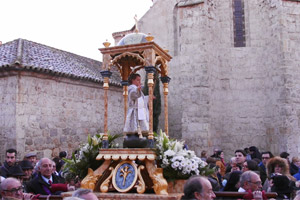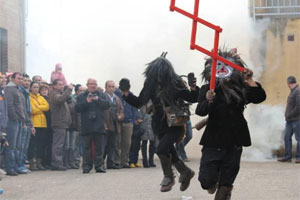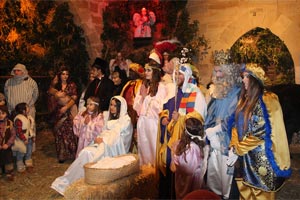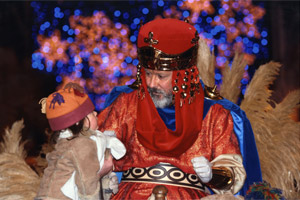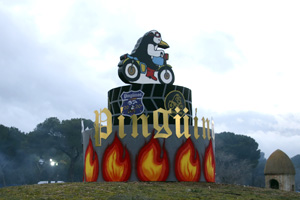Puertollano's Feast of the Holy Vow
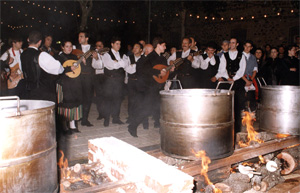
What is the Feast of the Holy Vow about
Puertollano celebrates a centuries-old tradition called the Holy Vow, which originated from the Black Plague that affected Europe in the 14th century. This festivity commemorates the vows made by the few surviving families to the Virgin Mary to save them from the disease. After surviving, each year, on the Thursday of the Octave of the Ascension, 13 cows (one for each surviving family) were sacrificed, and their meat and bread were distributed among the needy of the city.
Although more than six centuries have passed, the tradition continues, and cultural and recreational events have been added, such as medieval markets and the appointment of knights and dames of the Holy Vow. One of the highlights of the celebration is the preparation and distribution of the Holy Vow stew, which is cooked in 25 large pots with tons of firewood and served in about 5,000 containers.
The festivities take place near the Virgin of Grace, in the Paseo de San Gregorio, and usually include a tour of the city and its surroundings. The Holy Vow has been declared a Regional Tourist Interest Festival and an Intangible Cultural Heritage of Spanish Historical Heritage.
Main Elements of the Holy Vow
The Holy Vow in Puertollano involves several key elements that give life to this traditional festivity.
One of the first is the elaboration of a manifesto to announce the celebration, which is distributed to the Town Halls of nearby towns. However, over time, promotion has focused mainly on Puertollano due to the significant increase in population and industrial activity in the area.
Another prominent element is the 'paseíllo de la vaquilla', an ancient practice used as a means of advertisement and also as an additional source of revenue. Although this tradition has lost that purpose, in recent years a new version has been introduced where a dressed heifer entertains children and onlookers who enjoy having their photographs taken with it.
The purifying bonfires are another important element. For centuries, peasants used to light bonfires as part of rituals to ward off diseases and epidemics. These bonfires were made by the villagers, who collected objects from each house and burned them on the outskirts of the village, trusting that the smoke would carry away diseases.
The religious function is a central component of the festival. Before the Civil War, arrangements were made to ensure the participation of prominent ecclesiastical orators at the hermitage of the Patron Saint. The ceremony included the classic offering of flowers followed by the solemn Salve a Nuestra Señora, after which the characteristic local dances began.
Music and dances also play a fundamental role in the Holy Vow. Since the end of the 19th century, the Banda Municipal de Música has been responsible for the musical performance during the festivity. Choirs and dance groups from towns throughout the province perform mayos in honour of the Patron Saint. These artistic expressions promote brotherhood and bring pleasure to the audience.
A deep-rooted tradition is the May Song to the Virgen de Gracia. This popular prayer, performed by several rondallas, uses instruments such as guitars, bandurrias, flutes and requintos. The song reflects the devotion of the people of Puertollano to Our Lady and refers to the plague, which is the origin of the Vow festival, and to the hermitage erected in honour of the Virgin of Grace.
Last but not least is the distribution of the food. A specific place is prepared for the preparation and distribution of the food, with beef as the main ingredient. The staff appointed by the City Council are in charge of cooking from the early hours of the morning before the day of the Voto, and at midday on Thursday the food is distributed to the citizens and visitors who patiently wait in organised queues. This food is essential, as it fulfils the promise to feed the poor of the locality and neighbouring villages, as well as all the devotees who request it.
Main events that take place on the feast day
The main day of the festivity is celebrated during the Octave of the Ascension, specifically on Thursday, however, both before and after a series of enriching activities take place.
Wednesday
- To begin with, the buns are distributed at the Glorieta de Virgen de Gracia. More than 30,000 rolls are distributed among the crowd so that they can be enjoyed at home. These rolls are provided by local bakeries.
- Presentation of the Voto cow at the Glorieta de Virgen de Gracia. During this event, the cow is accompanied by groups of elderly people dressed in medieval costumes and the Disciples of San Juan with their drums, creating a festive and traditional atmosphere.
- In the Pedro Almodóvar Municipal Auditorium, the Order of the Holy Vow awards take place, recognising outstanding people for their contribution to the festivity. This act is a special moment where the commitment and dedication of those who have actively participated in the celebration is highlighted.
- The Santo Voto Folklore Festival is another of the activities that take place during the festivity. Various folkloric groups take part in this festival, offering performances full of music and traditional dances, thus providing a cultural and entertaining spectacle for those attending.
- The festival culminates with the traditional lighting of the 24 pots in the Glorieta de la Virgen de Gracia. This symbolic moment marks the beginning of the preparation of the Santo Voto meal, where the beef and other ingredients will be cooked and distributed the following day. The lighting of the pots creates an atmosphere of anticipation and preparation for the central culinary moment of the festivity.
Thursday
- Collection of the buns by the children.
- Mass of the Virgen de Gracia.
- Blessing and distribution of the Holy Vow stew.
Various organisations and associations join in this festivity, including the folkloric associations Virgen del Enebro, Fuente Agria and Virgen de Gracia, as well as the Disciples of San Juan. In addition, individual participation plays a fundamental role, as every year dozens of volunteers join in regardless of their age, sex or ideology. These volunteers actively collaborate and fulfil a series of promises during the days of the tradition, bringing their commitment and enthusiasm to the celebration.
Origin and History
In a distant year of 1348, when the devastating Black Death was ravaging Europe, it also reached Puertollano, reducing its population to just 13 families, comprising a total of 75 inhabitants. Seeking protection, these families went to the church of Nuestra Señora de la Asunción and spent the night in vigil, praying fervently for the Virgin Mary to intercede and deliver them from the plague. As a result of that night of prayer, all the families were spared from the contagion.
The 13 surviving families promised to thank the Virgin Mary for her intervention, pledging to hold a meal in her honour for the poor of the area. The intercession of the Virgin was evident and the neighbours fulfilled their promise, adopting the name of Virgen de Gracia (Virgin of Grace).
The meal of the Holy Vow consisted of the offering of a cow by each of the 13 families, with the purpose of celebrating a fraternal banquet and providing food for the most needy, sharing it with the inhabitants of the nearby villages who came in search of the intercession of the Virgin of Grace.
In 1489, with the appearance of a new epidemic, a second vow was made. The villagers indicated the place where a new chapel was to be erected in honour of the Virgin, and after this act was carried out, the spread of the disease ceased. In the 18th century, it is said that a bread roll from the Santo Voto stew cured a coachman of the Duke of Medinaceli, who had visited the town and shared a meal with the locals.
Throughout history, this ancient tradition has undergone changes, but has maintained its spirit. The food has undergone several variations, incorporating different types of meat, introducing potatoes and abandoning rice, among other changes. The small earthenware pots have given way to large metal pots, and elements such as the Manifesto, the cow walk and the purifying bonfires have disappeared.
It is important to note that the discovery of mining led to the abandonment of agriculture and livestock farming, as well as the arrival of a large number of immigrants who influenced the traditional customs of the locality.
For many years, the authorities and representatives of the clergy were the first to taste the stew, followed by the distribution among thousands of neighbours who formed long lines. The evening before, even longer lines formed to collect the rolls.
The Santo Voto was a deeply rooted tradition in the village, but suffered a significant setback at the end of the 19th century when the so-called "raciones de preferencia" (preference rations) were introduced. These rations were sent to the homes of certain prominent individuals, blessed and selected.
Nowadays
Nowadays, metal pots and pans are used to cook the Santo Voto meal, in contrast to the old clay pots. The tradition of the Holy Vow is the oldest in Puertollano and has been celebrated annually since 1348. Nowadays, the festivity begins on the Wednesday before Pentecost Sunday, with the blessing of the bread by the priest in the gazebo next to the church. This is followed by the symbolic 'cow walk', which heralds the lighting of the bonfires to heat the stew cauldrons. The cow walk used to be a way of raising funds, but nowadays it does not have that economic purpose.
In addition, a Musical Festival with folk songs is held at the Virgen de Gracia roundabout, and a song dedicated to the Patron Saint of Puertollano is sung, symbolising the faith and admiration of the people for the Virgin. Finally, around midnight, the bonfires are lit to start cooking the sacred stew, which will be blessed and distributed on Thursday to all interested citizens.
In recent years, new activities have been introduced to enrich the tradition, broaden its scope and encourage participation. These include the Order of the Holy Vow Awards, where Knights and Dames of the Holy Vow are appointed, as well as the holding of a Medieval Market on Paseo El Bosque, which has been well received by the public, and the Photographic Rally.
What to see in Puertollano
Puertollano is a city in the province of Ciudad Real, which offers several places of interest for visitors. Here are some of the highlights worth visiting in Puertollano:
- Fuente Agria: The Fuente Agria is one of the most emblematic symbols of Puertollano. It is a fountain with ferruginous waters containing a high iron content, which gives it a characteristic flavour. In addition to its peculiarity, the Fuente Agria also has a pleasant natural setting, perfect for strolling and enjoying the peace and quiet.
- The Promenade: Puertollano offers several promenades and green areas that invite you to take a relaxing stroll. One of the most outstanding is the Paseo de San Gregorio, located in the city centre. This promenade has landscaped areas, fountains and benches to rest, creating a pleasant atmosphere to enjoy a quiet stroll.
- Church of the Assumption: This impressive church is one of the main architectural landmarks of the city. Built in the 16th century, it combines Gothic and Renaissance elements and houses works of religious art of great value.
- Municipal Museum: Located in the former Hospital de Santa Misericordia, the Municipal Museum exhibits a varied collection ranging from archaeology and ethnography to contemporary art. It is an excellent way to learn about local history and culture.
- Parque del Pozo Norte: This extensive park is perfect for relaxing and enjoying nature. It has green areas, fountains, walking paths and playgrounds for children. It is an ideal place for a picnic or a quiet stroll.
- Parque del Pilar: Another beautiful park in Puertollano, the Parque del Pilar offers large green areas, ponds with ducks, rest areas and a peaceful atmosphere. It is a popular place for locals and visitors who wish to enjoy the outdoors.
- Centro de Arte Contemporáneo: Located in a former coal factory, the Centro de Arte Contemporáneo de Puertollano hosts exhibitions and events related to modern and contemporary art. It is a must for art and culture lovers.
- Monumento al Minero: Puertollano has a strong mining tradition, and the Monumento al Minero pays tribute to the coal workers. The sculpture is an important symbol of the city and reflects its industrial past.
These are just some of the attractions that Puertollano has to offer. The city also boasts a rich gastronomy, with traditional dishes.
What to eat in Puertollano
The typical popular gastronomy of Puertollano stands out for its traditional flavour and abundant dishes. Some of the most representative dishes include:
- Pisto Manchego: This is a stew of vegetables such as tomato, pepper, courgette and aubergine, cooked with olive oil. It is a colourful and tasty dish that is usually accompanied with fried egg.
- Manchego Shepherd's Migas: Manchego Shepherd's Migas is a traditional dish from the La Mancha region. It is prepared with crumbled stale bread, garlic, bacon or chorizo, olive oil, green bell pepper, and salt. The bread is soaked and fried with the oil and garlic to create a crispy exterior and a soft interior texture. The flavor stands out due to the combination of ingredients, which impart a smoky and spicy touch, thanks to the chorizo or bacon. It is served hot, and in some places, it is often accompanied by grapes or oranges for a contrast of flavors. Manchego Shepherd's Migas is a delicious, rustic, and comforting dish with an authentic taste of La Mancha's cuisine.
- Gachas Migas: This recipe consists of breadcrumbs, which are mixed with garlic, olive oil, paprika and other seasonings. It is usually served with sausages, such as chorizo or bacon, and is a hearty and comforting dish.
- Atascaburras: This typical Christmas dish consists of a paste of potatoes, crumbled cod, garlic and olive oil. It is served with hard-boiled egg and is usually spread on bread.
- Asadillo Manchego: This is a cold salad made with roasted peppers, tomato, garlic and olive oil. It is usually served as an accompaniment or as part of a tapa.
- Perdiz en Escabeche: The partridge is cooked in a marinade made of vinegar, oil, spices and other ingredients. It is left to rest so that it acquires its flavour and is served cold. It is a typical dish for celebrations and special events.
- Duelos y Quebrantos: A combination of eggs, chorizo, bacon and ham, all fried in olive oil. It is a hearty dish full of flavour.
- Puchero: A traditional stew that combines meats, such as beef, pork and chicken, with vegetables and pulses such as chickpeas and beans. It is a nutritious and hearty dish, ideal for cold days.
- Perrunillas: These are traditional biscuits made with flour, lard, sugar and cinnamon. They have a crunchy texture and are a very popular sweet in the area.
These are just a few examples of the typical popular gastronomy of Puertollano. The city has a varied culinary offer where you can enjoy homemade, tasty dishes rooted in local tradition.

